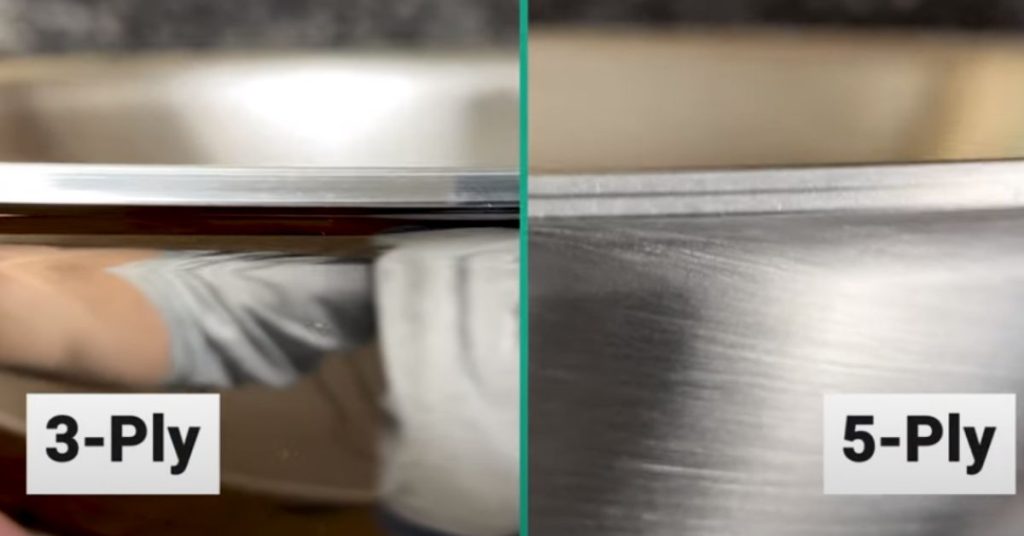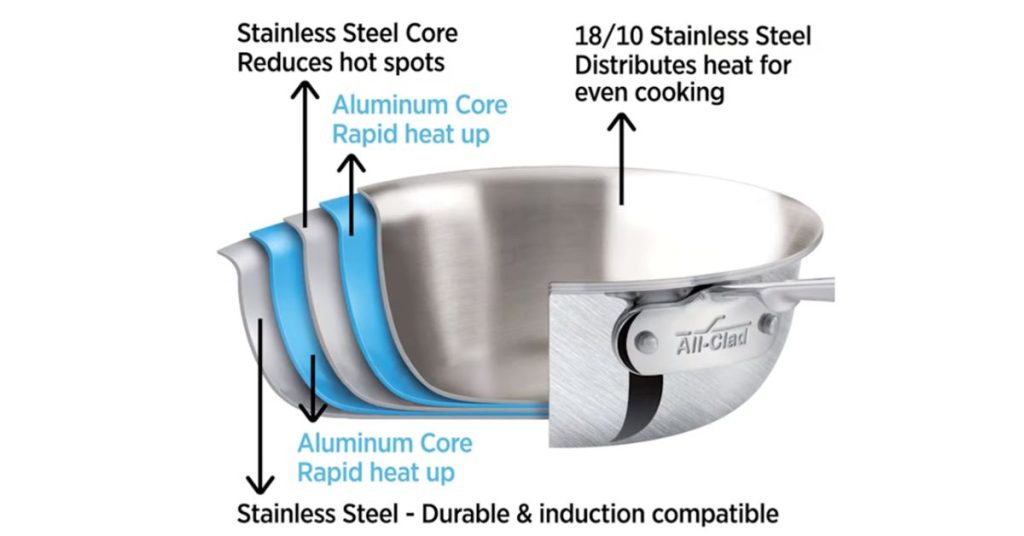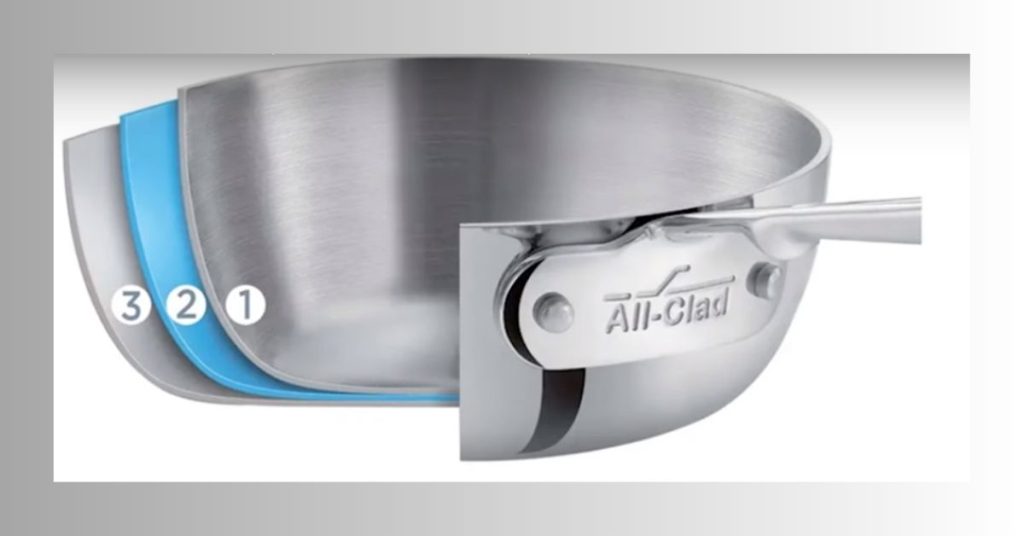As an Amazon Associate, I earn from qualifying purchases

Introduction
In the quest for the perfect cookware for your kitchen, the sheer abundance of choices can prove daunting. A frequent quandary that numerous kitchen enthusiasts encounter is the selection predicament of 5-ply versus 3-ply cookware.
Within this extensive manual, we shall explore the fundamental disparities separating these cookware variants, analyzing their composition, efficiency, and overall worth. Ultimately, you will attain a precise comprehension of the superior choice that aligns with your culinary requirements.
Construction and Design
5-Ply Cookware

Cookware classified as 5-ply stands distinguished for its remarkable capacity to conduct heat efficiently and uniformly. The “5-ply” nomenclature denotes the incorporation of multiple metal layers during its fabrication, typically encompassing stainless steel, aluminum, and occasionally copper.
The stainless steel layers contribute to its durability and furnish a non-reactive cooking surface, while the aluminum or copper layers amplify both heat preservation and conduction.
3-Ply Cookware

In contrast, 3-ply cookware is characterized by the inclusion of three metal layers, commonly comprising stainless steel wedged between two layers of aluminum or copper.
Although it may not exhibit an equivalent degree of heat conductivity as its 5-ply counterpart, it nevertheless ensures commendable heat dispersion.
Moreover, it presents a more budget-friendly option for individuals seeking economical alternatives.
Performance
Heat Distribution
The dissimilarity in heat distribution stands as a prominent contrast between 5-ply and 3-ply cookware. The incorporation of extra metal layers in 5-ply cookware imparts exceptional proficiency in uniformly dispersing heat throughout the cooking surface, effectively reducing uneven hot spots and ensuring consistent outcomes.
This attribute proves especially advantageous when handling delicate recipes or dishes necessitating precise temperature management. In comparison, 3-ply cookware may not achieve an equal level of heat distribution as its 5-ply counterpart, yet it still delivers satisfactory performance.
The inclusion of aluminum or copper layers aids in facilitating heat distribution, albeit to a slightly lesser extent.
Heat Retention
Regarding heat retention, both 5-ply and 3-ply cookware exhibit commendable performance. The presence of aluminum or copper layers in both variants aids in the retention of heat, enabling you to sustain the desired temperature throughout the cooking process.
This attribute proves particularly advantageous when executing techniques such as searing, sautéing, or preparing dishes that necessitate prolonged exposure to heat.
Durability
Durability represents a pivotal aspect to contemplate when selecting cookware. 5-ply cookware, owing to its multiple metal layers, tends to manifest as more robust and less prone to warping. The inclusion of stainless steel layers significantly enhances its durability, rendering it well-suited for prolonged utilization.
In contrast, 3-ply cookware, although not as structurally robust as its 5-ply counterpart, still presents satisfactory durability. It can endure regular kitchen usage and serves as a viable choice for individuals seeking affordability without sacrificing quality.
Maintenance and Care
Maintenance and care for both 5-ply and 3-ply cookware are generally straightforward. The stainless steel surfaces of both alternatives are non-reactive and resistant to stains. To safeguard their long-term durability, it is prudent to adhere to the care instructions provided by the manufacturer.
These guidelines commonly recommend hand washing the cookware using a mild detergent and refraining from using abrasive cleaning tools or utensils. By following these instructions, you can effectively maintain the quality and extend the lifespan of your cookware.
Price and Value
This makes it a favorable choice for individuals with a limited budget or those who are starting to assemble their cookware collection. Despite the lower price point, 3-ply cookware still provides satisfactory performance and durability.
However, if you are a passionate home cook or a professional chef seeking exceptional performance and longevity, investing in 5-ply cookware might be the preferred option. The additional layers of metal and superior heat distribution justify the higher price tag for those who prioritize precision and excellence in their culinary pursuits.
FAQs
Q: Which type of cookware provides better heat distribution? A: 5-ply cookware offers superior heat distribution due to the additional layers of metal. It ensures even heat across the cooking surface, minimizing hot spots. However, 3-ply cookware also provides satisfactory heat distribution, although not as precise as 5-ply.
Q: Does 3-ply cookware retain heat effectively? A: Yes, both 5-ply and 3-ply cookware retain heat effectively. The presence of aluminum or copper layers in both types helps to retain the desired cooking temperature.
Q: Is 5-ply cookware more durable than 3-ply cookware? A: Yes, 5-ply cookware tends to be more durable due to its multiple layers of metal. The stainless steel layers contribute to its robustness and resistance to warping. However, 3-ply cookware still offers satisfactory durability for regular kitchen use.
Q: Which option is more affordable? A: Generally, 3-ply cookware is more budget-friendly compared to 5-ply cookware. If you are on a tight budget or starting your cookware collection, 3-ply cookware offers a cost-effective option without compromising quality.
Q: Is it worth investing in 5-ply cookware for better performance? A: Investing in 5-ply cookware is worth considering if you are a passionate home cook or a professional chef seeking top-notch performance, durability, and precise heat distribution. The additional layers of metal justify the higher price tag for those who value excellence in their culinary endeavors.
Q: Can I use both types of cookware on different cooktops? A: Yes, both 5-ply and 3-ply cookware are compatible with various cooktops, including gas, electric, and induction. Make sure to check the manufacturer’s instructions for specific compatibility details.
Q: Can 5-ply and 3-ply cookware be used in the oven? A: Yes, both types of cookware are oven-safe. However, it is important to check the manufacturer’s guidelines for the maximum oven temperature and any specific recommendations for safe usage.
Q: Can I use metal utensils with 5-ply and 3-ply cookware? A: It is generally recommended to avoid using metal utensils with both types of cookware to prevent scratching the cooking surface. Instead, opt for wooden, silicone, or nylon utensils to maintain the cookware’s integrity.
Q: Are 5-ply and 3-ply cookware dishwasher-safe? A: While some 5-ply and 3-ply cookware sets are labeled as dishwasher-safe, it is advisable to hand wash them to prolong their lifespan and preserve their performance. The high heat and harsh detergents in dishwashers may degrade the cookware over time.
Q: Can I use 5-ply and 3-ply cookware with high-acidity ingredients? A: Yes, both types of cookware can handle high-acidity ingredients without any adverse reactions. The stainless steel surfaces of the cookware are non-reactive and safe for cooking acidic foods.
Conclusion
When it comes to the comparison between 5-ply and 3-ply cookware, each option has its own advantages and suits different requirements and budgets.
While 5-ply cookware stands out in terms of even heat distribution, long-lasting durability, and overall performance, 3-ply cookware provides a more economical alternative without compromising on quality.
Ultimately, your choice should be guided by your cooking style, individual preferences, and financial circumstances.
Whether you opt for the outstanding performance of 5-ply cookware or the budget-friendly nature of 3-ply cookware, you can have full confidence that both options will elevate
your culinary pursuits and empower you to effortlessly craft mouthwatering dishes.
To know more you can visit our site.